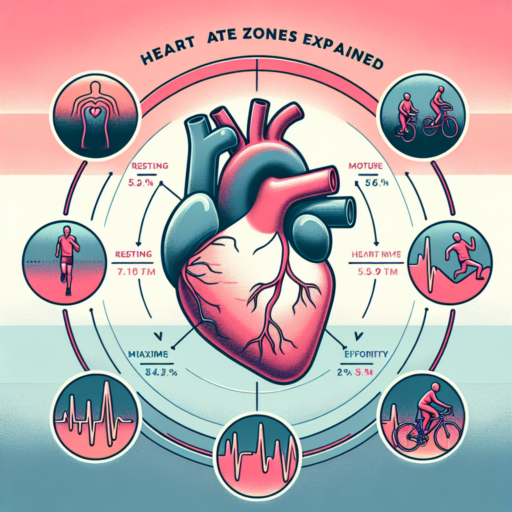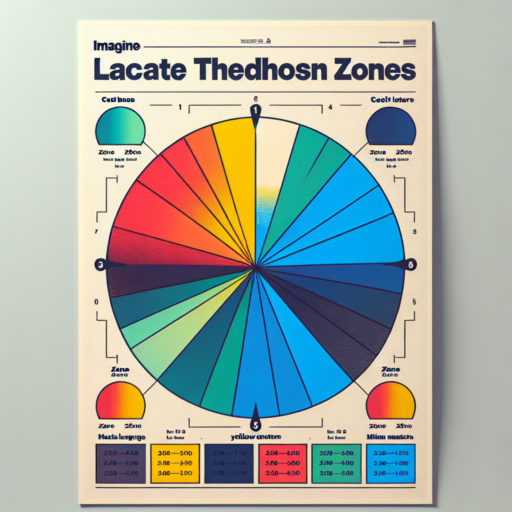Understanding Heart Rate Zones: A Comprehensive Guide
Exploring the realms of fitness and health optimization, understanding heart rate zones emerges as a key element in customizing workout plans and achieving fitness goals efficiently. These zones, which vary from one individual to another, are essentially brackets of your heart rate, each representing a different level of exercise intensity. By acknowledging and utilizing these zones, individuals can ensure their workouts are not just effective but also safe and tailored to their personal health and fitness objectives.
What are Heart Rate Zones?
At its core, the concept of heart rate zones divides your maximum heart rate into different ranges. These ranges are designed to guide you in reaching specific fitness outcomes, from fat burning to improving cardiovascular endurance. Typically, there are five main zones, starting with Zone 1, which promotes light activity and recovery, moving up to Zone 5, which targets maximum effort and peak performance. Each zone serves a distinct purpose, pushing the body to adapt and improve in various aspects of physical wellness.
Calculating Your Heart Rate Zones
Calculating your personalized heart rate zones requires knowing your maximum heart rate (MHR). A popular starting point is the formula «220 minus your age,» though it’s worth noting this method offers only an estimation and may not be entirely accurate for everyone. Once you have your MHR, you can apply percentages to identify the heart rates that correspond to the different zones. For instance, Zone 1 usually ranges from 50% to 60% of your MHR, making it ideal for low-intensity activities and recovery.
No se han encontrado productos.
How to Calculate Your Personal Heart Rate Zones
Understanding your personal heart rate zones is pivotal for maximizing efficiency in workouts and tracking your cardiovascular health. These zones are specific ranges of your heart rate, measured in beats per minute (BPM), that reflect different intensity levels of exercise. By calculating your personal heart rate zones, you can tailor your workout regime to suit your fitness goals, whether it’s improving endurance, burning fat, or strengthening your heart.
Step 1: Determine Your Maximum Heart Rate (MHR)
To begin, you need to ascertain your Maximum Heart Rate (MHR), a crucial number for setting your personalized heart rate zones. An accessible method for estimating your MHR is to subtract your age from 220. For example, if you are 30 years old, your estimated MHR would be 190 beats per minute. Remember, this is an estimation and individual differences can occur.
Step 2: Identify Your Heart Rate Zones
Once you have your MHR, you can calculate your heart rate zones, which are typically broken down into five main categories. These include the Healthy Heart Zone (50-60% of MHR), Fitness Zone (60-70% of MHR), Aerobic Zone (70-80% of MHR), Anaerobic Zone (80-90% of MHR), and Red Line Zone (90-100% of MHR). Each zone serves a unique purpose in your fitness journey, from improving basic endurance to enhancing lactate threshold.
By following these steps and understanding the significance of each heart rate zone, you can optimize your workouts for better results and health improvements. It’s essential to listen to your body and adjust as necessary, since these calculations provide a guideline rather than a one-size-fits-all solution.
The 5 Heart Rate Zones Explained: From Resting to Maximum Effort
Understanding the 5 heart rate zones is pivotal for athletes and fitness enthusiasts aiming to maximize their workouts efficiently. These zones range from very light intensity, ideal for improving basic endurance and recovery, to very hard intensity levels, which increase performance and speed. Knowing which zone you’re in helps tailor your training sessions for optimal results.
The first zone, often referred to as the Resting or Recovery Zone, operates at 50-60% of your maximum heart rate. It’s primarily used for warm-up and cool-down exercises, helping the body to recover by encouraging blood flow to the muscles without overexerting them. Then, we transition into the Light Zone (60-70% of maximum heart rate), which aims at fat burning and improving overall fitness, still allowing for comfortable conversation.
Moving up, the Moderate Zone pushes the heart rate to 70-80%, where aerobic benefits are maximized, improving cardiovascular and respiratory health. Here, conversations become more challenging. The Hard Zone, or 80-90% of your maximum heart rate, steps into higher intensity training, enhancing your VO2 max and lactate threshold, crucial for performance athletes. Lastly, the Maximum Effort Zone demands 90-100% of your heart rate, reserved for short bursts of effort, like sprinting, that push your limits to the maximum.
Benefits of Training in Different Heart Rate Zones
Understanding and leveraging the benefits of training in different heart rate zones can significantly enhance your fitness routine. Each zone corresponds to a specific percentage of your maximum heart rate (MHR), and training within these zones can help you achieve various fitness goals, from fat loss to peak performance. Here are some of the key benefits:
Improved Cardiovascular Fitness
Training in your lower heart rate zones, often referred to as the endurance or aerobic zones, is crucial for building cardiovascular endurance. This training intensity is gentle enough to encourage fat burn while improving the heart’s ability to pump blood and the muscles’ ability to utilize oxygen. Over time, this leads to improvements in your overall cardiovascular fitness, enabling you to exercise longer and with less perceived effort.
Enhanced Fat Burning
Targeting the moderate heart rate zones optimize the body’s fat burning capabilities. At these levels, your body prefers fat as its primary fuel source, offering a sustainable energy supply. This strategic approach to training not only aids in weight management but also increases your efficiency in metabolizing fats as fuel during both exercise and rest.
Peak Performance Training
High-intensity workouts that push you into your higher heart rate zones are critical for improving speed, power, and performance. Training in these zones, even for short periods, stimulates adaptations in your muscular strength and anaerobic capacity. It’s in these peak zones that the highest rate of calorie burn occurs, alongside enhancements in your ability to handle intense exercise bouts, making it an essential component for athletes looking to achieve peak performance.
How Knowing Your Heart Rate Zones Can Improve Your Workout Efficiency
Understanding your heart rate zones is a crucial component of maximizing workout efficiency. By categorizing your effort into distinct zones, each correlating to a specific percentage of your maximum heart rate, you can tailor your exercise regime to meet your fitness goals more effectively. This personalized approach ensures you’re not overexerting or undertraining, leading to optimal health benefits and improved performance over time.
The Benefits of Heart Rate Zone Training
Heart rate zone training allows for a targeted workout session that can drastically enhance your fitness levels. Whether your objective is to improve cardiovascular endurance, burn fat, or increase your sprinting power, each heart rate zone serves a unique purpose. For instance, lower zones are ideal for warming up and recovery, while higher zones challenge your aerobic and anaerobic thresholds, improving overall athletic performance.
Moreover, knowing which zone you’re training in helps to prevent overtraining and injuries. Overtraining in higher zones without adequate recovery can lead to burnout and increased risk of injuries. Conversely, training too lightly and not reaching the heart rate zones necessary for your fitness goals can result in stagnant progress. By understanding and applying heart rate zone knowledge, you’re better equipped to structure a balanced, efficient, and sustainable workout plan.
Tools and Gadgets to Monitor Your Heart Rate Zones
Monitoring your heart rate zones is crucial for maximizing your workout efficiency, improving cardiovascular health, and tracking your overall fitness progress. With technological advances, a wide range of tools and gadgets have emerged, making it easier than ever to keep an eye on your heart rate zones. Whether you’re a fitness enthusiast or just starting on your health journey, understanding and utilizing these devices can greatly enhance your workout outcomes.
Wearable Technology has revolutionized the way we monitor our fitness levels. Devices like smartwatches and fitness bands are equipped with sensors that track your heart rate 24/7, providing real-time feedback on your heart rate zones. These gadgets not only track your active and resting heart rates but also analyze the data to give insights into your overall health and fitness. Popular brands such as Fitbit, Apple, and Garmin offer a range of products tailored for different needs and budgets, ensuring there’s something for everyone.
For those who prefer more accuracy and detail in their heart rate zone monitoring, chest strap monitors are an excellent choice. Unlike wearable tech worn on the wrist, chest straps measure electrical signals from the heart, offering more precise heart rate data. This makes them ideal for athletes and serious fitness enthusiasts who require detailed analytics to optimize their training and recovery. Brands like Polar and Wahoo have developed chest straps that are comfortable to wear and easily connect with other devices, making it simple to integrate heart rate zone tracking into your existing fitness regime.
Heart Rate Zones for Cardio vs. Strength Training: What You Need to Know
Understanding the difference in heart rate zones for cardio versus strength training is crucial for optimizing your workout routine and achieving your fitness goals efficiently. While both types of exercise are vital for cardiovascular health and overall fitness, they impact heart rate differently, reflecting how your body uses energy during each activity.
Identifying Heart Rate Zones
Heart rate zones are typically divided into five main categories, each representing a specific percentage of your maximum heart rate (MHR). For cardiovascular exercises such as running or cycling, targeting higher heart rate zones (70-85% of MHR) can improve aerobic capacity and endurance. In contrast, strength training activities like weight lifting usually maintain your heart rate in lower zones (50-70% of MHR), which enhances muscular strength and anaerobic endurance without overly taxing the cardiovascular system.
Benefits of Each Zone for Different Training Types
- Cardio Training: Engaging in workouts that elevate your heart rate into higher zones will primarily improve your lung capacity, heart strength, and fat burning. It’s the intensity of these workouts that facilitates cardiovascular improvements and weight loss.
- Strength Training: While staying in lower heart rate zones, strength training focuses on muscle building and toning. This lower intensity still benefits your heart but does so by increasing muscle strength, which can improve your resting metabolic rate and overall physique.
Both cardio and strength training play distinct and important roles in a balanced fitness routine, addressed through their respective heart rate zones. By monitoring and adjusting these zones as part of your workout plan, you can more effectively meet your personal health and fitness objectives.
Tips for Staying Within Your Target Heart Rate Zone During Exercise
When it comes to optimizing the benefits of your workout, understanding and staying within your target heart rate zone is crucial. This sweet spot, where your heart is beating at an ideal pace, enhances cardiovascular fitness and burns calories efficiently. Below are essential tips to ensure you’re exercising within your ideal heart rate range.
Know Your Numbers
First and foremost, you need to determine your target heart rate zone. You can calculate this by subtracting your age from 220 to find your maximum heart rate. Then, aim to exercise at 60-80% of this number. For example, a 30-year-old would have a maximum heart rate of 190 beats per minute (bpm), making their target zone approximately 114-152 bpm. Always consult with a healthcare provider before starting any new exercise regimen to ensure it’s safe for you.
Use Technology to Your Advantage
Employing a heart rate monitor or a fitness tracker can be a game-changer in maintaining your desired heart rate zone. These devices provide real-time feedback, allowing you to adjust your exertion level as needed. Look for models that are easy to use during exercise and offer continuous heart rate display. This tool can help you stay on track, whether you’re running, biking, or engaging in any cardio activity.
Listen to Your Body
While technology is a helpful guide, paying attention to your body’s signals is paramount. If you find yourself feeling dizzy, lightheaded, or excessively fatigued, it’s crucial to slow down regardless of what your heart rate monitor says. Symptoms like these can indicate that you’re pushing too hard, even if you’re within your target heart rate zone. Conversely, if you can easily sing a song while exercising, you might not be pushing hard enough and could benefit from increasing your intensity.
The Science Behind Heart Rate Zones and Exercise Intensity
Understanding the relationship between heart rate zones and exercise intensity is crucial for optimizing workouts and achieving fitness goals. Each heart rate zone corresponds to a specific percentage of your maximum heart rate (MHR), dictating various intensity levels of exercise. These zones are pivotal for tailoring your fitness routine for either fat burning, cardiovascular improvement, or enhancing endurance.
When we talk about heart rate zones, it’s important to understand how they are calculated and their impact on exercise intensity. The five main zones, ranging from very light to maximum effort, guide individuals in identifying exercise intensity that aligns with their fitness objectives. Knowing which zone you are training in can help ensure that you are exercising at the right intensity to meet your specific goals, whether it’s improving aerobic capacity or strengthening the cardiovascular system.
Each zone serves a distinct purpose:
- Zone 1: This is the very light intensity zone, ideal for warming up and cooling down.
- Zone 2: Often referred to as the fat-burning zone, this moderate intensity level is where the body efficiently uses fat as its primary energy source.
- Zone 3: This is the moderate to hard intensity zone, where aerobic and endurance training occurs, improving cardiovascular health and stamina.
- Zone 4: At this intense level, anaerobic exercise begins, enhancing speed and muscle strength.
- Zone 5: This is the peak intensity zone, used for short bursts of maximum effort training to increase power and speed.
By understanding and utilizing these heart rate zones, individuals can more effectively plan their workouts to include a mix of intensities, thereby maximizing the efficiency and results of their exercise regimen. Tracking heart rate during exercise and staying within the appropriate zone ensures that each workout contributes to the desired fitness outcomes, be it fat loss, endurance improvement, or cardiovascular health.
Common Mistakes People Make with Heart Rate Zone Training
When it comes to maximizing the benefits of heart rate zone training, avoiding common pitfalls can help enhance your fitness routine significantly. This method, which involves exercising at different intensities based on heart rate zones to achieve specific fitness goals, is often misunderstood. Recognizing and avoiding these mistakes is crucial for effective training.
One widespread mistake is not personalizing the heart rate zones. Many individuals rely on generic heart rate charts or formulas without considering their unique physiological variables. This one-size-fits-all approach may lead to training in incorrect zones, either pushing too hard or not enough, thereby reducing the effectiveness of workouts and potentially increasing the risk of injury or burnout.
Another common issue is the failure to update heart rate zones. As you become more fit, your heart rate response to exercise will change. This means that your initial heart rate zones may no longer be accurate as your training progresses. Regular assessment and adjustment of these zones are essential to continue benefiting from heart rate zone training.
Ignoring Recovery Indicators
Ignoring the significance of recovery indicators is another mistake that can hinder the benefits of heart rate zone training. Recovery is as important as the workout itself. Training too often at high intensities without sufficient recovery can lead to overtraining and fatigue, making it harder to achieve fitness goals. Paying attention to signs of overtraining and ensuring adequate rest is integrated into your routine is key to maximizing the effectiveness of heart rate zone training.




